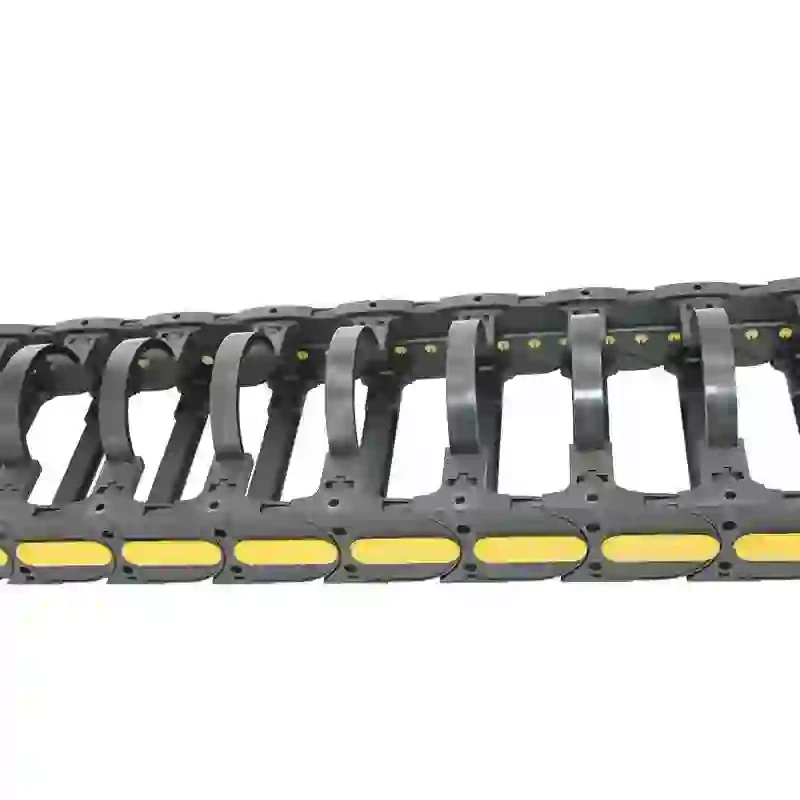semi enclosed cable chain
Understanding Semi-Enclosed Cable Chains Design, Functionality, and Applications
In the modern industrial landscape, where automation and precision play a crucial role in enhancing efficiency, the importance of effective cable management systems cannot be overstated. Among these systems, semi-enclosed cable chains have emerged as a pivotal solution for various applications in manufacturing, robotics, and more. This article delves into the design, functionality, and applications of semi-enclosed cable chains.
What is a Semi-Enclosed Cable Chain?
A semi-enclosed cable chain, also known as a cable carrier or drag chain, is a flexible assembly that provides a pathway for moving cables and hoses. Unlike fully enclosed chains, semi-enclosed designs allow for easier access and management of the cables within them while still protecting them from wear and environmental factors. These chains typically consist of interconnected links that form a continuous loop, enabling them to expand and contract smoothly as machinery moves.
Advantages of Semi-Enclosed Cable Chains
1. Protection and Durability One of the primary functions of a semi-enclosed cable chain is to protect the cables and hoses from abrasion, contamination, and mechanical damage. The semi-enclosed design offers a balance between protection and accessibility, ensuring that the internal components remain safe while still being easy to maintain.
2. Flexibility and Range of Motion Semi-enclosed cable chains are designed to be flexible, allowing them to accommodate various movements, including lateral, vertical, and rotational motions. This flexibility is crucial in dynamic environments, such as CNC machines and robotic arms, where equipment needs to move seamlessly without tangling or stress on the cables.
3. Easy Installation and Maintenance The design of semi-enclosed cable chains makes installation straightforward. They can be mounted in various configurations, such as horizontal or vertical setups. Furthermore, the ability to access the cables easily means maintenance can be performed without significant downtime.
Design Considerations
When selecting a semi-enclosed cable chain for a particular application, several design factors should be considered
- Material Quality materials such as nylon, polyethylene, or steel are often used to construct the chains. The choice of material affects durability, weight tolerance, and resistance to environmental factors like temperature and chemicals.
semi enclosed cable chain

- Link Structure The shape and size of each link in the chain impact flexibility and the overall system's ability to carry different cable sizes. A well-designed link structure minimizes wear and allows for smooth movement.
- Loading Capacity It's crucial to assess the cable load that will traverse the chain. Chains are available in various sizes and configurations to handle different loads, so selecting a model that aligns with the application’s requirements is essential.
Applications of Semi-Enclosed Cable Chains
Semi-enclosed cable chains are versatile and find applications across a wide range of industries
1. Robotics In robotic automation, these chains help manage the cables that provide power and control signals to actuators and sensors. Their flexibility accommodates the rapid movement and positioning of robotic limbs without causing cable strain.
2. Machinery and CNC Equipment In CNC machining centers, semi-enclosed cable chains organize the extensive wiring and tubing of coolant and air lines, keeping them protected and enhancing the tool’s operational efficiency.
3. Material Handling Systems In conveyor systems, semi-enclosed chains manage electrical and pneumatic cables required for operations such as sorting, packing, and transportation of materials.
4. Industrial Automation Beyond robotics, any automated assembly line can benefit from these chains, as they ensure safe cable routing and reduced maintenance issues.
Conclusion
Semi-enclosed cable chains are integral to modern machinery and automation systems, providing essential support for cable management. With their protective yet accessible design, they enhance the efficiency and longevity of equipment across various industries. As technology continues to evolve, the role of these cable carriers will likely expand, presenting new opportunities for optimization in automated processes. Ultimately, understanding their design and functionality can lead to more effective implementations and innovations in cable management.








